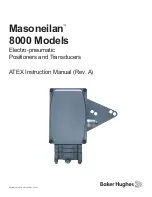
DT722 User’s Manual
14
97332 Issue 2, January 2018
APPENDIX D
•
Avoid using instruments in direct sunlight or near any other source of heat, unless they
are suitably shielded to prevent measurement errors.
Sampling in general
•
Relative humidity measurements should be carried out at a representative temperature.
Failure to allow temperature equilibration will lead to a false indication of the relative
humidity.
•
Variations in vapor pressure from place to place can occur where an environment is subject
to any addition or removal of water. If so, care must be taken over where to make a
measurement in order to obtain a representative result.
•
Sources and sinks of water vapor should be avoided in any sampling system. Invasion of
stray water can be minimised by attention to leaks, hygroscopic materials, droplets and
condensation. The lower the humidity, the more critical these precautions are.
•
Hygroscopic materials should be avoided. Many materials contain moisture as part of their
structure, particularly organic materials (whether natural or synthetic), salts (or anything
which contains them), and anything which has small pores. Temperature changes can
increase the tendency of these materials to affect the humidity of the surrounding air.
•
Condensation in a sampling process can invalidate humidity measurements by reducing
the water content of the gas being measured. What is more, condensed liquid may alter
the humidity elsewhere by dripping or running to other locations and evaporating there.
In these circumstances, measurement results may be misleading if hygrometer location is
not considered carefully.
•
Water droplets or mist must be avoided. These can result in overestimates of the humidity
of the air between the droplets. Such results may exceed 100% RH, or may be impossible
to interpret meaningfully. Droplets of liquid also damage some electrical types of humidity
sensor. Filtering the air sample can eliminate droplets.
•
If pumps are used for sampling gas, these should be located after the hygrometer, to avoid
contaminating the measurement environment. Where possible, oil free pumps should be
used, or filters employed. Oscillations in pressure due to pumping can sometimes be
reduced or buffered using a needle valve or a reservoir of large volume.
•
Special treatments such as filtration can change the amount of moisture in a gas. Some
drying agents take out other gases, too.
•
When sealing any sensor or probe into a port or manifold in a duct or chamber, leaks
through the probe or electrical cable should be considered. These are not always sealed
against passage of ambient air.
•
Where sampling involves a step change in temperature, pressure or gas flow rate, relative
to the process being sampled, results may need to be converted or interpreted. For
example ‘pressure dew point’ will differ from the value found after expanding the gas
sample to atmospheric pressure. Care should be taken to distinguish between ‘gauge’ and
absolute values of pressure.
Dew point in general
•
The measuring environment and all parts of the sampling pathway must be kept above
the dew point if condensation is to be avoided. Electrical trace heating or other heating
methods should be used if necessary. An excess temperature of 10°C above the dew point
is usually a safe margin.
•
For measurements in the region below 0°C it must be clear whether the condensate is dew
or frost. Failure to distinguish between these can result in errors of about 1°C for every
10°C below zero.





































